NO.54 You need to map the Dynamics 365 Finance components into the standard models.
Which component belongs to which model? To answer, drag the appropriate models to the correct components. Each model may be used once, more than once, or not at all. You may need to drag the split bar between panes or scroll to view content.
NOTE: Each correct selection is worth one point.
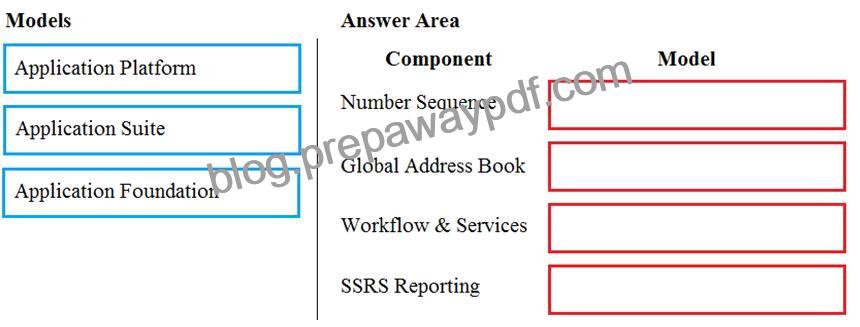
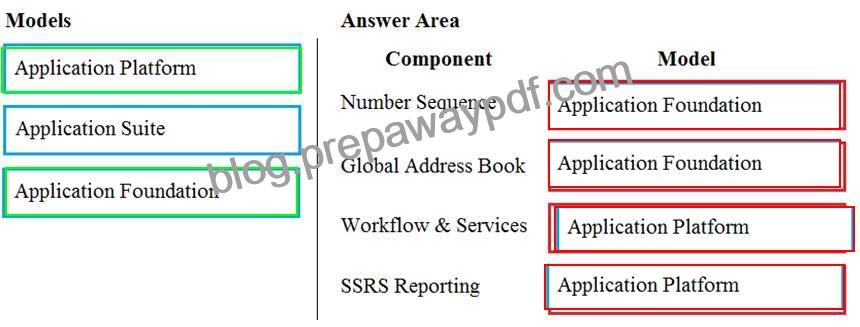
Reference:
https://docs.microsoft.com/en-us/dynamics365/fin-ops-core/dev-itpro/dev-tools/application-stack-server-architecture
NO.58 You are a Dynamics 365 Finance developer. You create a key performance indicator (KPI) in a development environment.
You need to display the KPI.
What should you do?
KPIs and aggregate data that are shown on the dashboard, or a workspace, can be secured by using menu items.
Reference:
https://docs.microsoft.com/en-us/dynamics365/fin-ops-core/dev-itpro/analytics/model-aggregate-data Integrate and Manage Data Solutions Testlet 1 Case study This is a case study. Case studies are not timed separately. You can use as much exam time as you would like to complete each case. However, there may be additional case studies and sections on this exam. You must manage your time to ensure that you are able to complete all questions included on this exam in the time provided.
To answer the questions included in a case study, you will need to reference information that is provided in the case study. Case studies might contain exhibits and other resources that provide more information about the scenario that is described in the case study. Each question is independent of the other questions in this case study.
At the end of this case study, a review screen will appear. This screen allows you to review your answers and to make changes before you move to the next section of the exam. After you begin a new section, you cannot return to this section.
To start the case study
To display the first question in this case study, click the Next button. Use the buttons in the left pane to explore the content of the case study before you answer the questions. Clicking these buttons displays information such as business requirements, existing environment, and problem statements. If the case study has an All Information tab, note that the information displayed is identical to the information displayed on the subsequent tabs. When you are ready to answer a question, click the Question button to return to the question.
Background
Wide World Importers sell office supplies, furniture, and fittings to their customers across the United States.
The company has the following locations:
* a retail store in Seattle
* a warehouse in Seattle
* a customer support and call center in Atlanta
* a team of field workers that provide furniture installation services at customer sites.
Wide World Importers plans to implement Dynamics 365 Finance and Microsoft Azure cloud platform features.
Current environment
Customers may place orders by email, phone, or by using the company’s website. The company authorizes and processes credit card transactions by using a web-based application. Customer, inventory, supplier, and other master and transactional data is stored in a legacy database.
The company collects feedback from customers by phone or a form on the company’s website and maintains the data in a Microsoft Excel workbook.
Wide World Importers runs on-premises applications to manage payroll and workers compensation. The company has a set of Microsoft Power BI dashboards that present data from a reporting database.
The company creates a Lifecycle Services (LCS) implementation project and completes Dynamics 365 Finance onboarding.
The company maintains production, quality assurance (QA), development, user acceptance testing (UAT), and build environments.
Requirements
General
* You must configure a cloud-based Dynamics 365 Finance development environment and enable code extension that support updates.
* You must configure version control and a Build environment.
* You must migrate all legacy data to the new system.
* You must implement best practices for X++ coding, the data model, caching, and security.
* All new code must be unit tested in a development environment and then validated by the QA team before code is added to source control.
Business processes
You must configure vendor trade agreements.
Products must be shipped directly from suppliers to customers depending on customer location to save indirect costs.
You must collect customer feedback on products shipped directly from vendors.
You must deploy code to a UAT environment for testing before deploying code to production.
You must validate all entries for the purchase order creation form.
You must develop a web portal that allows customers to browse products, place orders, and check order status. Product data for the web portal must be integrated as periodic batches.
Business systems
* You must install and configure a third-party solution for credit card processing within Dynamics 365 Finance. The third-party company will provide a deployable package.
* The workers compensation application must be able to call an API to update worker compensation details in Dynamics 365 Finance.
* You must develop a process to import payroll journals into the system.
* You must configure the warehouse mobile device portal for warehouse operations.
* You must install a third-party solution to support web portal integration. The solution is supplied as a source code model file.
Vendor exclusion list
You must develop a new solution to maintain a Vendor exclusion list for each customer and item combination.
The solution must meet the following requirements:
* Isolate all new vendor exclusion codes as a new assembly by creating a table named VendExclusions.
* Create an index for the table named PrimaryIdx that uses the following fields: CustAccount, ItemId, VendAccount.
* Ensure that users can open the Vendor Exclusion list report from the customer master form. The list must display the customer account, Item ID, and Vendor account fields.
* Implement the Excel integration for the Vendor Exclusion List form.
* Provide functionality to periodically export the Vendor exclusion list to prepare reports by using standard reporting capabilities of Dynamics 365 Unified Operations.
* Develop necessary security permissions to view and maintain the new Vendor exclusion list functionality and reporting. Users with maintain rights will be able create, update, and delete the exclusion list.
Permissions must be assigned to security roles to match company security model.
* Maintain referential integrity with other tables.
* Users must be presented with a warning message before a direct delivery purchase order is created for a vendor in exclusion list.
* Sales managers must be alerted when a new exclusion record is added to the system.
Security
* You must implement the record level audit feature to identify the users who created the record.
* Grant specific users rights to maintain the vendor exclusion list by using Excel.
* You must implement validation to check whether a proposed direct delivery purchase order vendor is on the exclusion list for the customer and product combination.
Issues
User1 is not able to access many features in the system. You must provide User1 administrator rights.
A sales manager suspects a data-related issue in the vendor exclusion list. User1 must identify the user who created the referenced exclusion records.
Developer2 joins the company and does not have access to a development environment or source control.
User2 reports performance issues when they generate direct delivery purchase orders after current updates are applied.
User2 reports that they cannot access new functionality and reports.
NO.62 You are a Dynamics 365 Finance and Operations developer.
You have the following code: (Line numbers are included for reference only.)
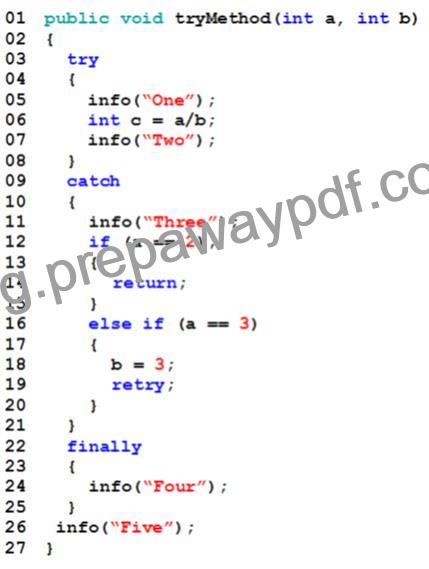
You need to evaluate the code.
What is the correct output for the method? To answer, select the appropriate option in the answer area.
NOTE: Each correct selection is worth one point.

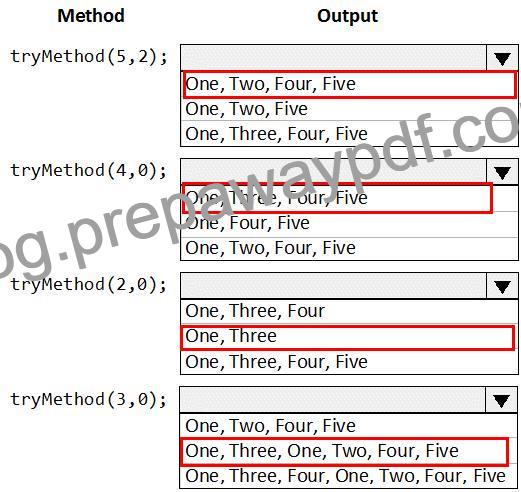
Explanation:
Box 1: One, Two, Four, Fire
The statements in the finally clause are executed when control leaves the try block, either normally or through an exception.
Box 2: One, Three, Four, Five
Box 3: One, Three
Return ends the call.
Box 4: One, Three, One, Two, Four, Five
Retry restarts the try statement.
Reference:
https://docs.microsoft.com/en-us/dynamics365/fin-ops-core/dev-itpro/dev-ref/xpp-exceptions
NO.63 You need to implement the integration for the Vendor Exclusion List form.
What should you do? To answer, select the appropriate options in the answer area.
NOTE: Each correct selection is worth one point.
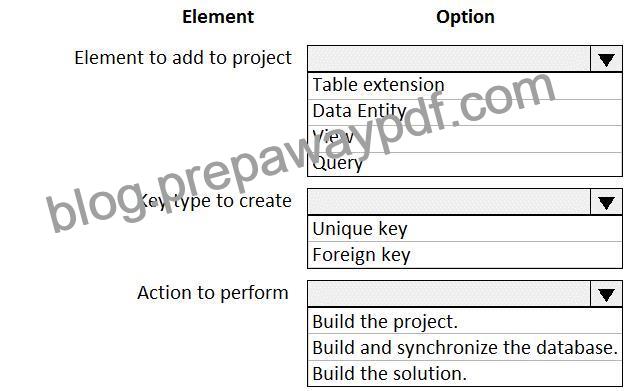
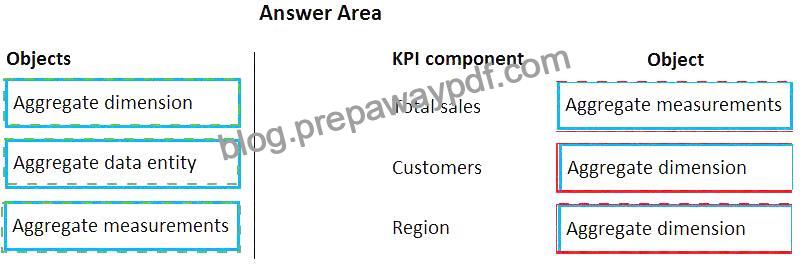
Explanation
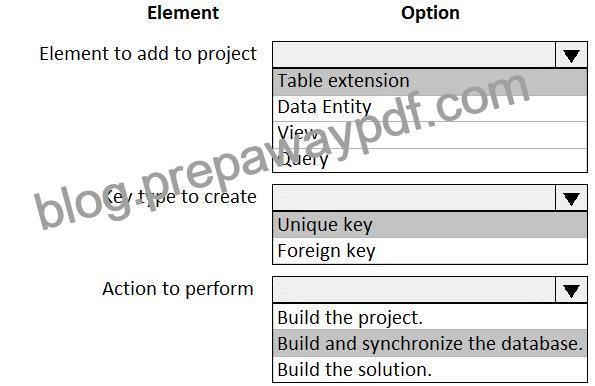
Box 1: Table extension
Isolate all new vendor exclusion codes as a new assembly by creating a table named VendExclusions.
Implement the Excel integration for the Vendor Exclusion List form.
The table extension object allows you to add additional fields or to change some properties on a table provided by the Dynamics 365 Business Central service. In this way, you can add data to the same table and treat it as a single table.
Box 2: Unique key
Create an index for the table named PrimaryIdx that uses the following fields: CustAccount, ItemId, VendAccount.
Box 3: Build and synchronize the database.
A project property lets you specify that the synchronize operation for the database should be performed every time that you build the project. This can be useful when you’re making changes to the table structure for an application. Each time that you build, you will know that the database is synchronized with the tables as they are defined in the project.
Reference:
https://docs.microsoft.com/en-us/dynamics365/business-central/dev-itpro/developer/devenv-table-ext-object
https://docs.microsoft.com/en-us/dynamics365/fin-ops-core/dev-itpro/dev-tools/build-operations#synchronizing-
NO.64 You are a Dynamics 365 Finance and Operations developer.
You need to use the Extensible Data Security (SDS) framework to restrict to the data in the Sales table form based on the customer group and the role of the user.
Which four actions should you perform in sequence? To answer, move the appropriate actions from the list of actions to the answer area and arrange them in the correct order.
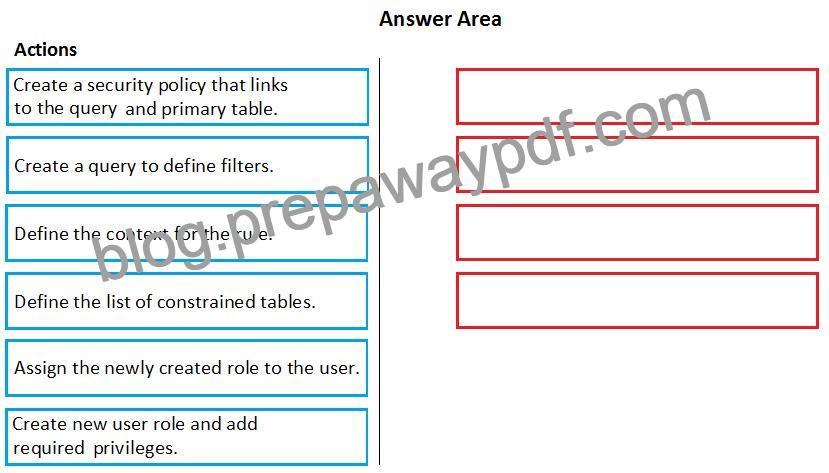
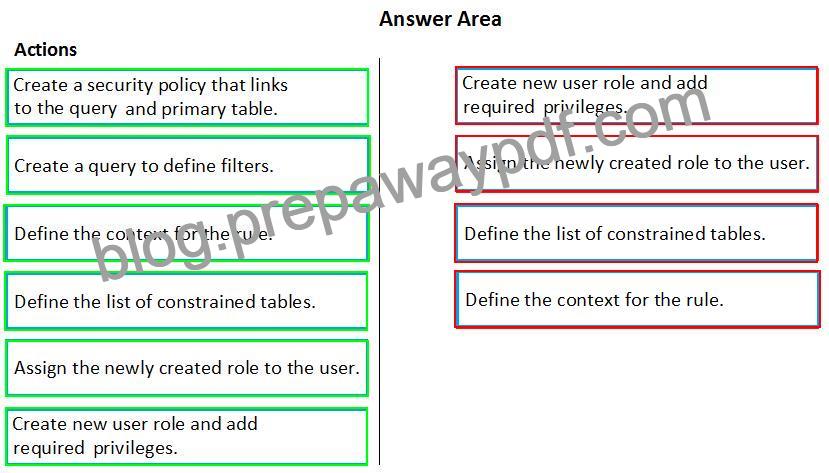
Explanation:
Step 1: Create a new user role and add required privileges.
Individual security permissions are combined into privileges, and privileges are combined into duties. The administrator grants security roles access to the program by assigning duties and privileges to those roles.
Step 2: Assign the newly created role to the user.
Step 3: Define the list of constrained tables.
Add the constrained tables and views.
Step 4: Define the context of the rule.
Set the context.
Set the ContextType property to one of the following:
* ContextString – Set the property to this value if a global context is to be used to determine whether the policy should be applied. When required, this context string needs to be set by the application using the XDS::SetContext API.
* RoleName – Set the property to this value if the policy should be applied only if a user in a specific role accesses the constrained tables.
* RoleProperty – Set the property to this value if the policy is to be applied only if the user is a member of any one of a set of roles that have the ContextString property set to the same value.
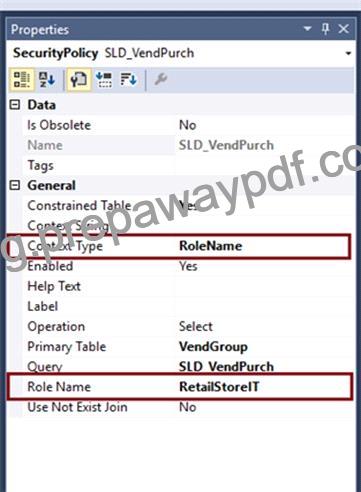
Reference:
https://docs.microsoft.com/en-us/dynamics365/fin-ops-core/dev-itpro/sysadmin/security-architecture
https://community.dynamics.com/365/b/exploringdynamics365/posts/extensible-data-security-in-d365
NO.67 You need to develop, test, and deploy the Vendor Exclusion list solution.
What should you create? To answer, drag the appropriate objects to the correct actions. Each element may be used once, more than once, or not at all. You may need to drag the split bar between panes or scroll to view content.
NOTE: Each correct selection is worth one point.
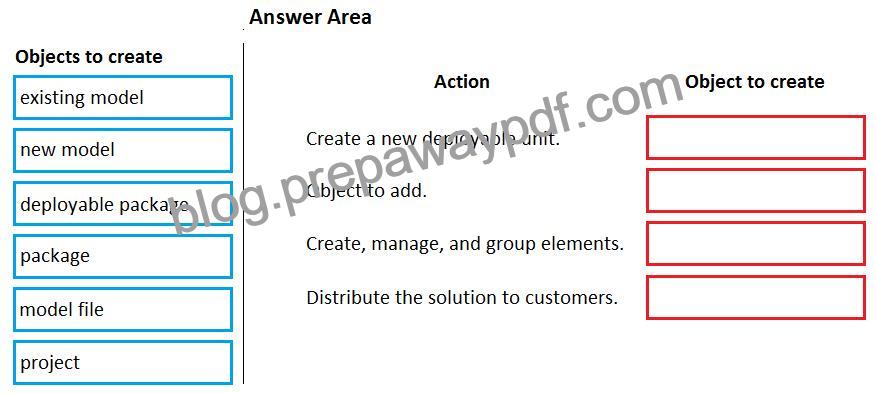
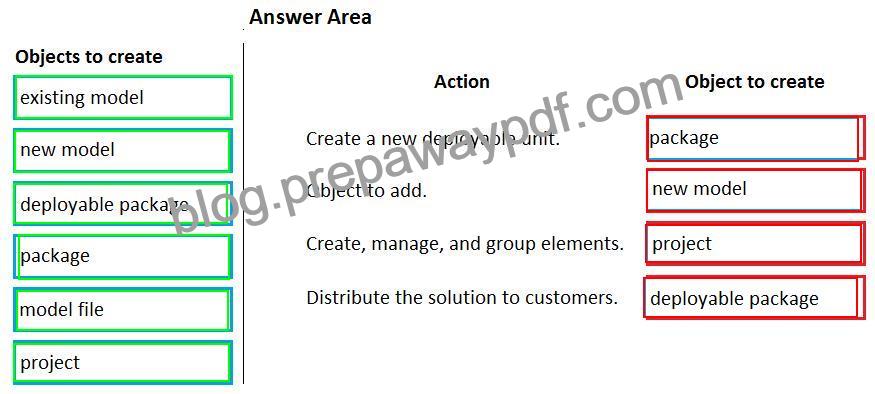
Reference:
https://docs.microsoft.com/en-us/dynamics365/fin-ops-core/dev-itpro/dev-tools/create-data-model-elements


